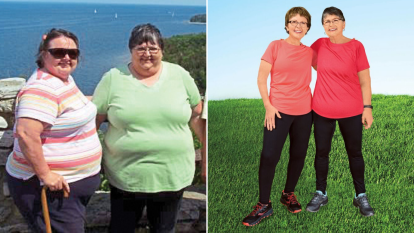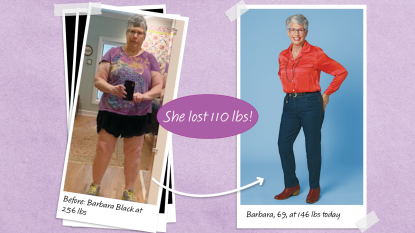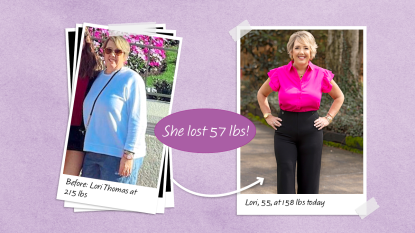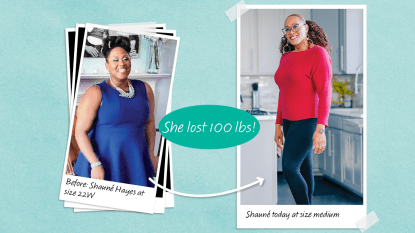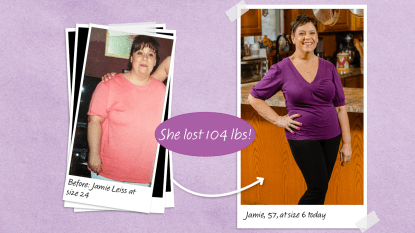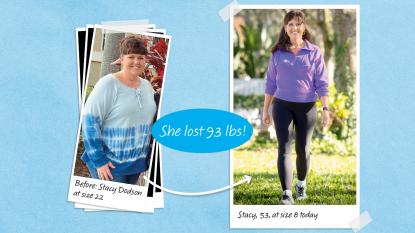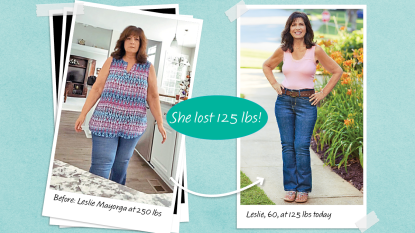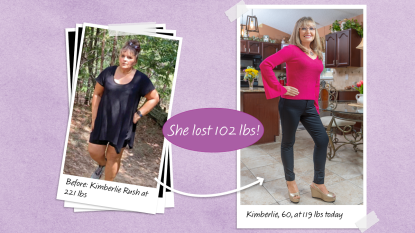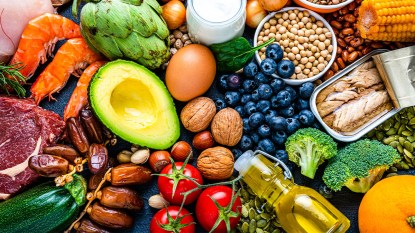Inspiring! She Lost 383 Lbs at Age 66 — And Here’s What Whole30 Can Do for You
Patty Markby, 66: “Once I focused on feeling good instead of weight loss, I had the most success with both. I’m the healthiest and happiest I’ve ever been!”
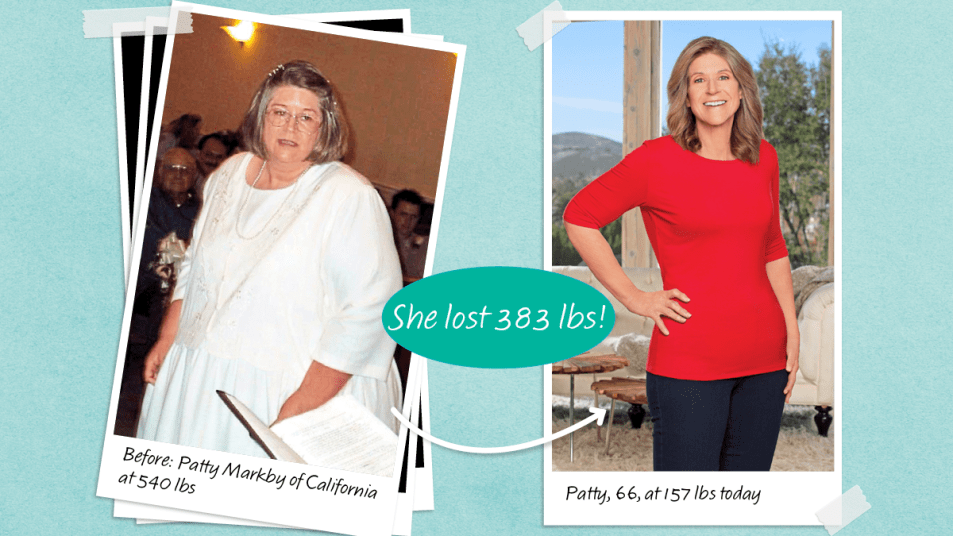
Month after month, year after year, The Whole30 has remained one of Amazon’s bestselling books on healthy eating. What sets it apart? Well, while most plans urge us to cut calories or carbs, Whole30 simply guides us to cut inflammation. The best part: You don’t have to go hungry to cut inflammation. Instead, you simply steer clear of foods that contain potential irritants, enjoying all the delicious anti-inflammatory fare you need to feel full. There’s nothing to count, nothing to measure. As inflammation comes down, the body naturally moves toward optimal health and a healthy weight. It’s basically an anti-inflammatory diet for weight loss and healing.
“People are always surprised by how many ways they can improve the quality of their life simply by eating good food,” notes nutritionist and Whole30 co-author Melissa Hartwig. How well does it work? Patty Markby used it to help lose 383 lbs and ease her chronic fatigue and joint pain. Read on for her story and to see what Whole30 could do for you.
Why use an anti inflammatory diet for weight loss and healing
As it turns out, the way most of us live these days literally irritates our bodies. Experts say that mountains of sugar and low-fiber junk, lack of exercise, constant stress, even hidden food sensitivities all trigger chronic inflammation in cells throughout our bodies. Swelling and fluid retention develop, inhibiting the function of everything from tiny mechanisms in cells to our joints, glands and major organs. Even our brains can be affected by inflammation. Since this inflammation can cause or worsen hundreds of health problems, the Whole30 plan was created to take aim at inflammation using food.
What you do on Whole30
When you start Whole30, for 30 days you eat only whole, natural foods and avoid any ingredients linked to internal inflammation. That means no added sweeteners, grains, legumes, peanuts, dairy or alcohol. The menu allows for unlimited amounts of nonstarchy vegetables, all varieties of potatoes, fruits, nuts, nut flours, nut milks, cocoa, natural fats, eggs, seafood, poultry and meat. Sip water or unsweetened coffee/tea. Eat three meals a day, listening to your body and eating enough so that you’re pleasantly full and won’t need snacks. That’s all there is to it. Preliminary research shows this way of eating reduces inflammation up to 82%.
After 30 days on Whole30
Once the first 30 days are done, Whole30 dieters test eliminated ingredients one at a time, eating a couple servings of, say, peanuts or yogurt a day for a few days. If there are no signs of inflammation — like weight gain, GI trouble, skin issues (itchiness, hives, rashes), congestion, fatigue, joint pain or body aches — freely enjoy the food going forward.
“When we clear inflammatory foods out of our diet, nothing but good can come from it,” says Molly Kimball, RD, of Ochsner Health System in New Orleans. Our brains, hearts, lungs, joints, livers, immune systems and digestive systems all operate more freely — and that’s just for starters. Our thyroids and cellular mechanisms involved in metabolism operate more freely, too, essentially unblocking stalled fat loss.
Says Wisconsin-based family physician and functional medicine expert Luc Readinger, MD: “I use Whole30 as one of the main tools in my clinical practice. It’s very rare to have a patient complete 30 days and not have improvement in a health condition or general vitality. For those who start out with weight to lose, I know if they have followed through on the program before I even see them based on the weight loss that my nurse records in their chart at the follow up appointment. The program keeps getting more popular because it gets results.”
Anti inflammatory diet success story: Nora Gocking
When Kentucky mom Nora Gocking heard the neurologist say “you have relapsing-remitting multiple sclerosis,” she felt the room begin to spin. She clutched her husband’s hand as the doctor spoke of brain lesions, drug regimens, future attacks. Nora looked at Brian and began to pray. “God, please let good come from this…”
Nora started meds to suppress her disease but continued to battle fatigue, twitching and numbness. When a friend suggested she look into Whole30, Nora found the approach could be life-changing for people exactly like her. Yet Nora felt doubt too. After all, she’d tried many diets with tenacity; she’d barely lose and eventually give up. “The scale doesn’t matter this time,” she reminded herself. “This is about driving out MS.”
Avoiding potentially inflammatory foods, she could still make many of her family’s normal meals with just little tweaks. Eggs, potatoes and fruit for breakfast and sautéed chicken with veggies and cauliflower rice for dinner.
She did battle some sugar withdrawal, but soon that passed, her appetite shrank, her energy soared higher than before the MS. After 30 days, she was down 50 pounds; all told, she dropped 185 pounds.
“When I first got sick, I prayed that good would come from a horrible situation — and that’s exactly what happened,” says Nora, who has been maintaining for years. “I feel better than I did before I got sick.” As for Nora’s MS, “I’ve had three beautiful MRI scans that show the disease hasn’t progressed at all since I started Whole30,” she says. “I love sharing my story. I want as many people as possible to have a chance to feel as amazing as I do!”
Click through to read more of Nora’s story
Anti inflammatory diet before and after: Patty Markby
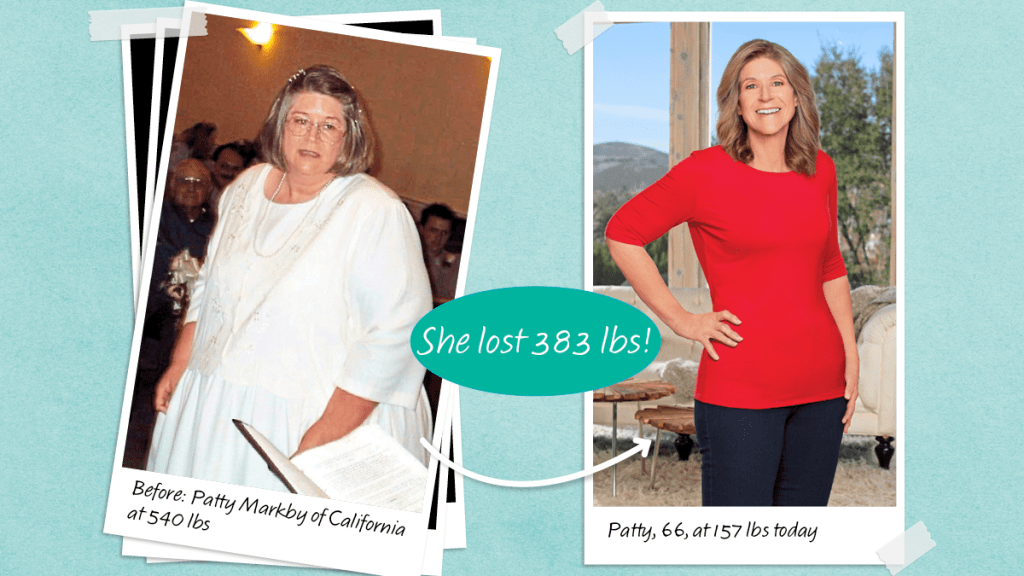
“No, no, no!” screamed Patty Markby, kicking her bathroom scale. Her husband, Al, rushed in. “I can’t lose even one pound,” she said, her eyes welling with tears. Al put a hand on her shoulder. Life had changed so much for Patty since she met him eight years ago. After decades of her seesawing between starvation diets and binges, Al’s unwavering support gave her the strength to try a healthier diet. She’d slowly gone from 540 pounds to 340 pounds. And it had been thrilling — until her progress abruptly stopped.
She tried eating less, painful walking workouts. Yet months ticked by with no change. “I messed with my metabolism for too long. Now it’s just broken,” she said. Patty still struggled to get around, couldn’t fit in a restaurant booth and had to sleep in a recliner. “I don’t want this to be as far as I go.” But how would she get her body to cooperate?
As fate would have it, Patty had an appointment scheduled to check her pacemaker. “Your blood work shows high C-reactive protein,” said the doctor. “It means there’s inflammation inside you that increases your risk of stroke, heart attack and a lot of other problems.” The doctor continued: “An anti-inflammation diet should help.”
Patty’s Whole30 journey begins
Patty began checking out resources the doctor recommended and was soon following guidelines from The Whole30. Patty stocked her kitchen with colorful produce, nuts, seeds, cocoa, coffee, olive oil, eggs, seafood and grass-fed meat. After years fixated on calories and carbs, Patty was no longer being asked to track anything. She just ate anti-inflammation foods until she felt comfortably full. Feeling rejuvenated, she stepped on the scale that hadn’t budged in years. She was down 20 pounds in 30 days. Four weeks later, after a follow-up blood test, her cardiologist marveled: “Your inflammatory markers have dropped from a 4 to a 0.1!”
Patty lost 183 pounds — for a total of 383 pounds gone — without limiting portions. She hit her goal at age 66. And when she finally experimented with eliminated foods, she was happy to find she could enjoy chocolate and wine without issue. But dairy and grains? They left her exhausted. Maybe they were my main problem all along, she thought.
Health bonuses piled up — vanishing joint pain, stronger immunity, deeper sleep — and she added gentle workouts. Eventually she had surgery to remove loose skin. She’s now a personal chef and health coach based out of the California home she shares with Al. “Once I focused on feeling good instead of weight loss, I had the most success with both. I’m the healthiest and happiest I’ve ever been!”
Related: How Whole30 Changed One Woman’s Life
Whole30 menu ideas to get you started
While using Whole30 guidelines, you’ll skip foods linked to inflammation (highly processed food, sugar, grains, beans, peanuts and dairy) as you load up on anti-inflammation options like produce, nuts, seeds, good fat, eggs, fish, poultry and meat. Drink anything natural and unprocessed, including water, black coffee, tea, nut milks. To avoid triggering hunger, Whole30 skips fruit juice. For the same reason you skip sweeteners of any kind in beverages. Enjoy three meals a day, eating enough so you won’t need snacks. We’ve got yummy ideas for you to try. Find complete Whole30 Program rules here.
Easy Whole30 Breakfast: Enjoy eggs, sauteed veggies or potatoes prepared with olive oil, nitrate-free bacon or sausage and optional fruit.
Easy Whole30 Lunch: Serve salmon over salad with arugula, red onion, olive oil, vinegar, and seasoning to taste; optional glass of iced green tea with lemon.
Easy Whole30 Dinner: Enjoy lean beef with roasted cauliflower or potatoes; for sauce, blitz 1 cup parsley, ⅓ cup olive oil, 3 cloves garlic and salt in a blender.
Bonus recipe: Easy sheet-pan salmon supper
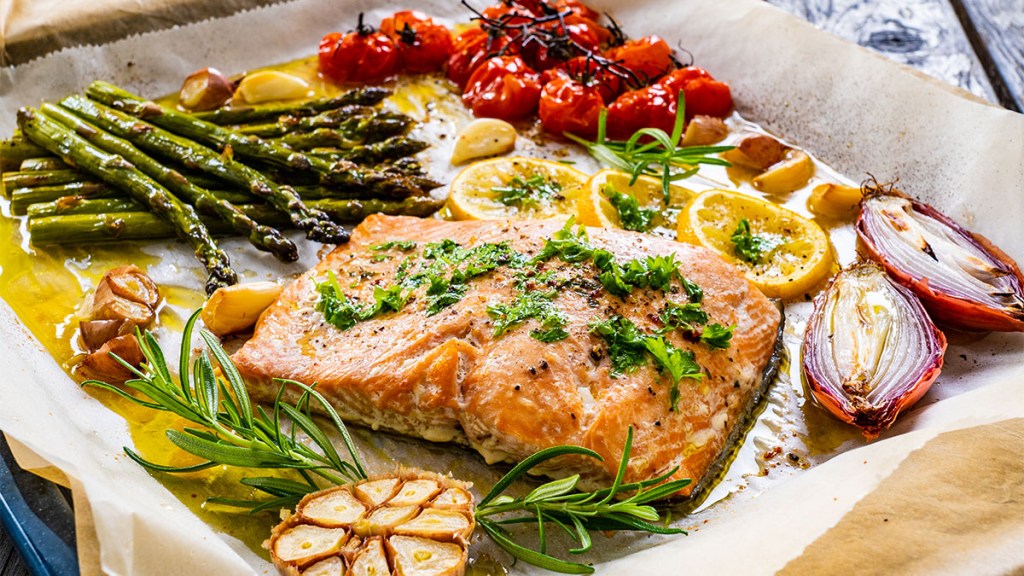
This ultra-easy weeknight dinner is yummy, healing and slimming
Ingredients:
- 4 salmon fillets
- 1 lb assortment of asparagus, grape tomatoes, halved onions and rosemary sprigs
- ¼ cup olive oil
- 4 tsp. minced garlic
- juice of ½ lemon
Directions:
- Arrange fish and veggies on a sheet lined with parchment paper.
- In small bowl, whisk oil, garlic and juice with salt and pepper to taste.
- Brush mixture on fish, then drizzle on veggies, tossing to coat.
- Bake at 425ºF until salmon is done, 13-15 minutes. Serves 4
Click through for more inspiring weight loss success stories:
Top Doc Reveals the Secrets of Women Who’ve Lost 150 Lbs With No Loose Skin
Weight Loss Success: “I Lost Faster At Age 71 Than Ever Before With This Protein Trick”
This content is not a substitute for professional medical advice or diagnosis. Always consult your physician before pursuing any treatment plan.
A version of this article originally appeared in our print magazine, Woman’s World.


